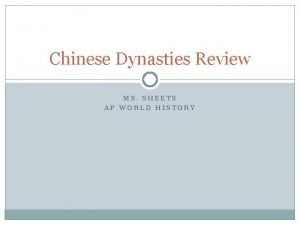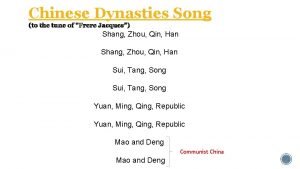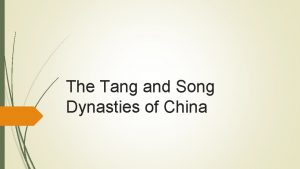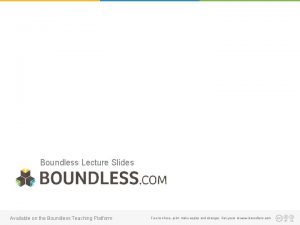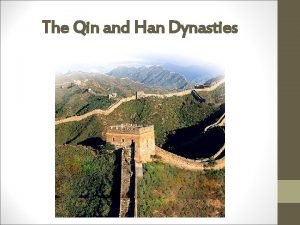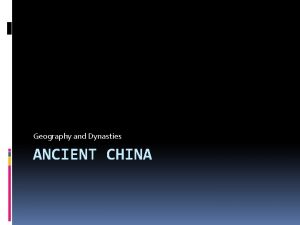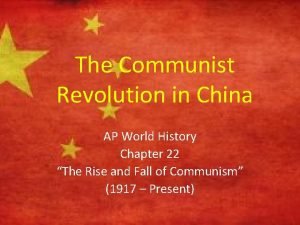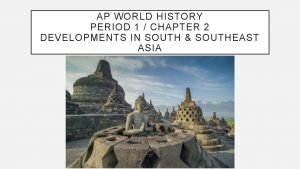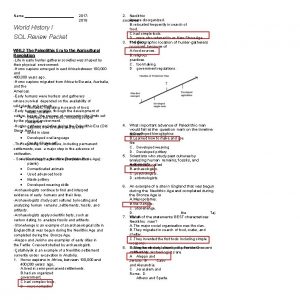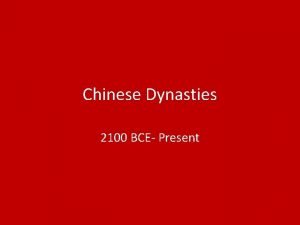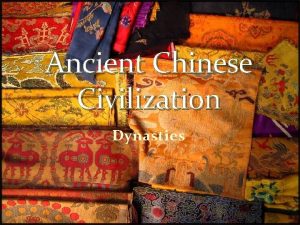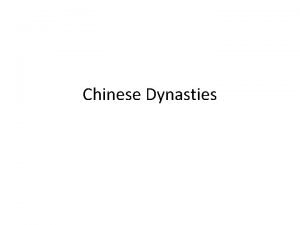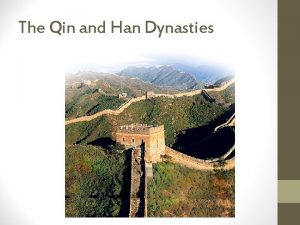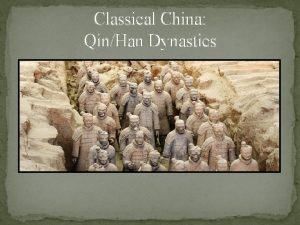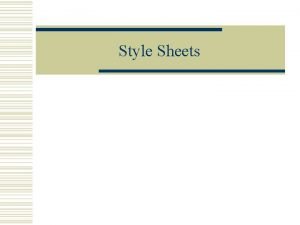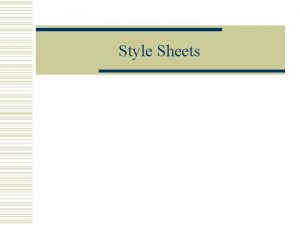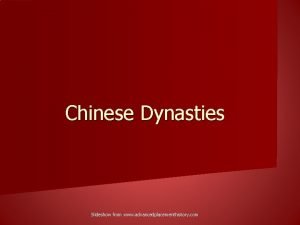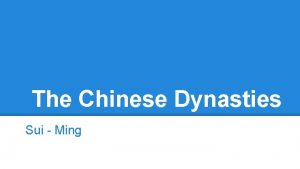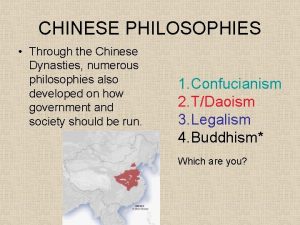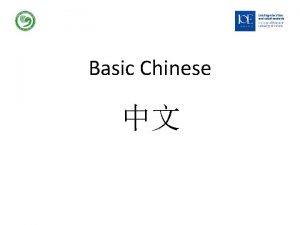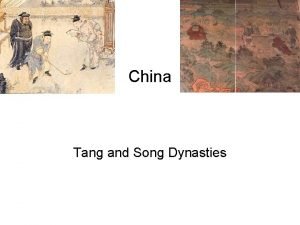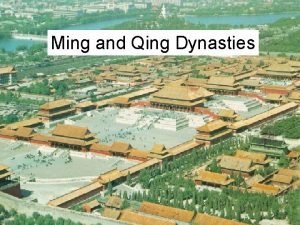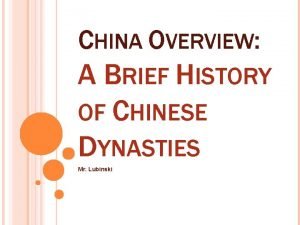Chinese Dynasties Review MS SHEETS AP WORLD HISTORY



















- Slides: 19

Chinese Dynasties Review MS. SHEETS AP WORLD HISTORY

Topography of China

Xia • Possible mythical dynasty

Shang • AKA Yellow River (Huang He) • Pottery, wheels, farms, silk: no discovered writing or how to use metals • Highly developed social classes: kings, nobles, commoners and slaves. • Developed in considerable isolation: develop agriculture on their own • Organized state with irrigation • Skilled horseback riders; used bronze, iron • First documented rule in China (Xia had no written records).

Zhou Created the “Mandate of Heaven” Used feudalism to create alliances Extended territory of China into the Yangtze River valley Promoted one standard language (Mandarin Chinese) Confucianism created

Era of Warring Kingdoms Zhou feudal regional rulers formed independent armies Zhou dynasty ended after the Era of the Warring States (402201 BCE)

Qin Shi Huangdi took control of feudal estates Created non-aristocratic officials to oversee provinces Centralization Great Wall of China was begun Calculate tax revenues and labor services more efficiently Standardized coinage, weights and measures

Han Emperor Wu Ti Developed examination system to prepare civil servants to work in government Extensive expansion of Chinese territory Trade routes led to contact with India, Parthian Empire, Roman Empire

Six Dynasties Includes: 1) Three Kingdoms Period (220 -280) 2) Jin Dynasty (265 - 420) 3) Southern and Northern Dynasties (420 -589)

Sui Return to strong dynastic control in China Promoted Buddhism Restored examination system Expensive building projects (Grand Canal)

Tang Li Yuan united China Bureaucracy rebuilt utilizing Confucian ideology Early Tang: pro. Buddhist (Empress Wu) Late Tang: Buddhist backlash (Emperor Wuzong) Emperor Xuanzong and An Lishan Rebellion (mutiny)

Five Dynasties and Ten Kingdoms Five Dynasties in Northern China succeeded one another rapidly Ten Kingdoms in Southern China existed concurrently and controlled their own territory

Song General Zhao Kuangyin overcomes all rivals but one: nomadic Liao dynasty in Manchuria Song pay tribute to Liao to keep them from raiding Neo-Confucians lead amongst scholars: promote footbinding Attempts at Reform with Wang Anshi Dynasty flees south when nomads invade

Southern Song New capital at Hangzhou: sophisticated, wealthy, commerce expands Politically and economically weak; culturally, it is a golden age

Yuan Kubilai Khan (grandson) led forces against Song beginning in 1235 Distinction between Mongol and Chinese Social standing in Yuan Dynasty (Mongols; Muslims and Asian nomads; Chinese) Yuan Court welcomed foreigners Chinese civil service exam was not used Mongols retreat escaped to central Asia when overthrown by Ju Yuanzhang

Ming Founded by Ju Yuanzhang (Hongwu) Returned China to tradition; remove Mongol influence Revive scholar-gentry (more complex) Bureaucracy purged of corrupt traitors Neo-Confucians dominate Huge population growth via new world crops 1433: Isolationism; end of Zheng He’s missions Decline when Manchus invade

Qing maintained political and social system of Ming Bureaucracy became corrupt. Yellow River Flood on Shandong peninsula Opium War: spheres of influence, extraterritorality rights Taiping Rebellion and Self -Strengthening Movement Boxer Rebellion and 8 Nation Alliance 1911: Republican Revolution

Republic of China Started by Sun Yat-sen Associated with Nationalists 1925: Led by Chiang Kai -Shek Chinese Civil War: vs. Communists 1950: end of Chinese Civil War Retreat to Taiwan; claim to still be legitimate government

People’s Republic of China Emerge as rebel group vs. Nationalists Ultimately led by Mao Zedong Glean support from peasants Remodeled along Soviet lines Great Leap Forward (industrial failure) Cultural Revolution (cleanse China of traditional culture)
 Ap world history chinese dynasties
Ap world history chinese dynasties Chinese dynasty acrostic poem
Chinese dynasty acrostic poem Shang zhou qin han sui tang song
Shang zhou qin han sui tang song Empress wu accomplishments
Empress wu accomplishments Houmuwu ding
Houmuwu ding China qin dynasty map
China qin dynasty map Chinese dynasties
Chinese dynasties Chinese dynasties
Chinese dynasties Cultural revolution definition ap world history
Cultural revolution definition ap world history Chinese communist revolution ap world history
Chinese communist revolution ap world history Sinhala dynasties ap world
Sinhala dynasties ap world Anglo chinese primary
Anglo chinese primary World history spring final exam review answers
World history spring final exam review answers World history 1 sol review
World history 1 sol review World history semester 2 final review packet
World history semester 2 final review packet World history semester exam
World history semester exam Whap period 3
Whap period 3 Hellenistic doctors increased their knowledge by
Hellenistic doctors increased their knowledge by World history fall final review answers
World history fall final review answers World history 1st semester final review answers
World history 1st semester final review answers
